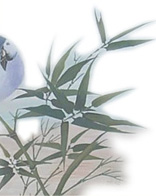|
 LISTEN: LISTEN:
 Hi, This is Shirley, today, for the first time, I would like to introduce you to a Chinese poem. It‚Äôs called ‚ÄúGoose‚ÄĚ, or in Chinese, ‚ÄúE‚ÄĚ Hi, This is Shirley, today, for the first time, I would like to introduce you to a Chinese poem. It‚Äôs called ‚ÄúGoose‚ÄĚ, or in Chinese, ‚ÄúE‚ÄĚ
This poem was written by Luo Binwang -- a poet who lived during the early Tang Dynasty (A.D.618‚Äē907), is a very famous Chinese ancient poem. Can you imagine? When the poet wrote it, he was only 7 years old. :-)
Its main meaning is:
Goose, goose, goose,
Bending her neck to sing to the sky,
Her white feather is floating on the green water,
Her red soles are rowing the blue waves.
In Chinese is:
E,E,E,
Qu3 jing4 (another version is "xiang")xiang4 tian1 ge1,
Bai1mao2 fu2 lu4 shui3,
Hong2zhang3 Bo1 Qing1bo1.
Maybe you’re surprised that Shirley put so many numbers next to the words
In Chinese, there are 5 tones: tone 1, tone 2, tone 3 and tone 4. Also there is a light tone. We can express it this way below:
-- / V \
1 2 3 4
I wrote the tone numbers by the words to help you to read them correctly.
For example: I read the word "Ma" with 5 tones in Chinese to express 5 meanings to you.
Ma1: -- tone 1 : means : mother
Ma2: / tone 2: means: tingle or hemp
Ma3: V tone 3: means: horse
Ma4: \ tone 4: means: call someone’s name.
Ma: means light tone. As an auxiliary word that indicates mood, to express an emotion.
Ok, I would like to tell you the the new words in this poem:
e2 : goose
qu3: bend
jing4: neck
xiang4: forward, to
tian1: sky
ge1: sing
bai2: white
mao2: feather
fu2: float
lu4: green
shui3: water
hong2: red
zhang3:sole
bo1: row
qing1: blue
bo1: wave
Now please follow me to read whole of the poem:
E,E,E,
Qu3 qing4 xiang4 tian1 ge1,
Bai1mao2 fu2 lu4 shui3,
Hong2zhang3 Bo1 Qing1bo1.
I do hope you enjoy it.
Note: I am so lucky for an England frind corrected my English after I put this poem on the web site. So, today, I re-edited my writting. If you have any questions, comments and suggestions. please write to shirley@ebridge.cn,you are welcomed.
--Shirley
Writed on 30th April, 2005
Edited on 1st.,May, 2005
Re-edited on 5th.,July,2005

|

